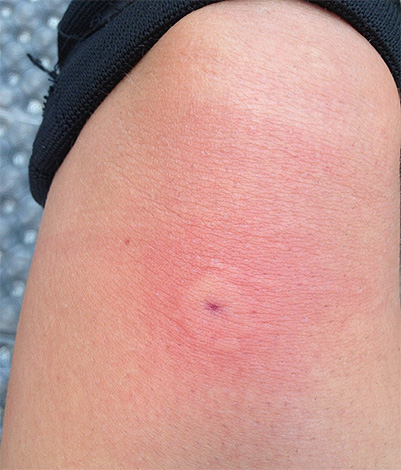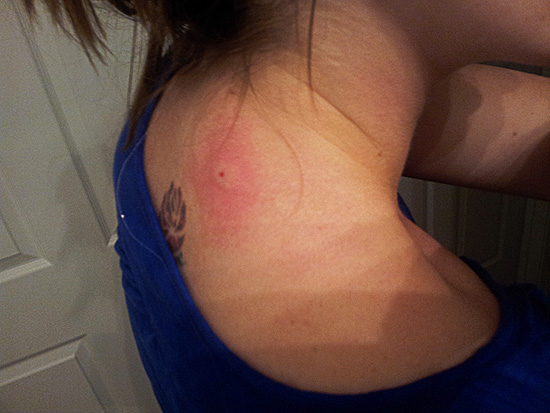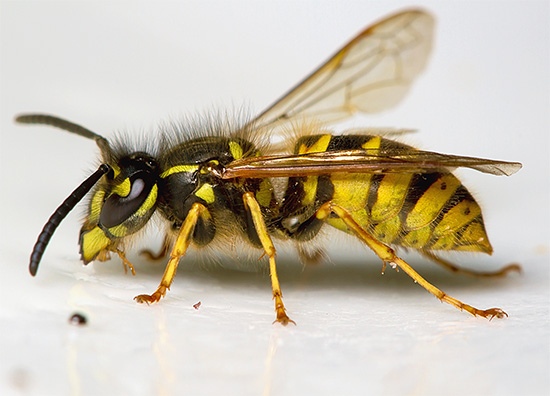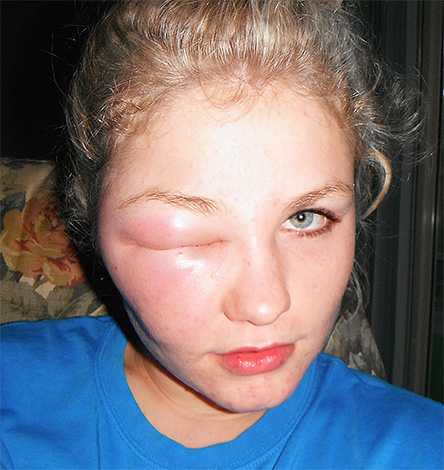
Few people know what a wasp bite is: its consequences are familiar to almost every adult, and many from memory from childhood. Severe pain, redness, swelling and itching - this is the standard reaction to wasp bite.
Meanwhile, the consequences of attacks of these insects can be much more severe. What is dangerous wasp sting? Let's understand ...

First of all, the bites of Hymenoptera insects (which include wasps, hornets, bees, and some others) are distinguished by their high allergenicity. In addition to the toxins that destroy the walls of the cells of the affected tissues and act on the nerve endings, the composition of wasp venom also contains substances that can cause a powerful immune response of the body.
If a person does not have hypersensitivity to wasp poison, he may not feel these allergens.If the victim is hypersensitive (such people are also called sensitized), a wasp sting can be even more dangerous for him than, for example, the attack of a poisonous spider.

Feedback
“I got an allergy card last summer after a wasp sting. I was always indifferent to them, because my grandfather was a beekeeper, so I was bitten by bees all my childhood. The doctor said that because of this and all the problems.
Near the dining room at work a wasp bitten me, my temperature rose, my head began to ache, a rash appeared on my face. She came home almost unconscious, her whole body was sprinkled. Well, that daughter immediately called an ambulance. They pumped me out. They said that it was very bad. Then the doctor looked, took tests, said that I have a very high sensitivity. And what if I do not have a special syringe with a medicine with me, then death from a wasp sting is quite possible for me. Such are the cases. "
Veronika, Zelenograd
The most unpleasant thing here is that no one really knows whether he has such sensitivity or not. It may be congenital, and may develop over time in response to the bites of various insects.Therefore, complications after the attack of the os could arise unexpectedly and with anyone.

On a note
A deadly bite from a wasp is a rarity, but it happens sometimes. For example, in the United States from the attacks of Hymenoptera annually killed more people than from snake bites. Moreover, not so much depends on the type of insect here: it can be fatal, like stinging an ordinary paper wasp, or a honey bee.
Wasp poison and its specificity
The poison of the wasp is in its composition in many respects similar to the poisons of other Hymenoptera — bees, hornets, bumblebees, some tropical ants — but it also has its own characteristics.

Here are some of the valid components of the wasp venom:
- phospholipases that cause destruction of cell walls, swelling and inflammation;
- melitin - a component that promotes hemolysis (destruction) of mast cells;
- apamin, a toxin that has a strong effect on the nervous system, including motor nerves;
- acetylcholine, which has a direct effect on the conduction of nerve impulses;
- Histamine, the main function of which is to start the mechanism of an allergic reaction (it is the action of antiallergenic drugs, which are called antihistamines) to neutralize histamine;
- MCD peptide destroys mast cells and causes an avalanche-like increase in the amount of histamine in the blood (as a result, the development of an allergic reaction is accelerated);
and some others.
Partly due to the destruction of the cell walls is the fact that the wasp sting often hurts for a long time and passes rather slowly: inflammation develops in the affected area, which disappears as the cells recover. When the walls of small blood vessels are destroyed, hemorrhage occurs - this is especially pronounced with hornets bites.

The reaction of people to the action of wasp venom is largely individual. On average, a healthy person has a wasp sting for several days, and its effects completely go through a week and a half.
In different species of wasp poison has a different composition. For example, the bite of the so-called road wasp, long and slender, is considered one of the most painful among all the known insects in the world (even more painful is the bite of a tropical ant bullet). But the bites of wild wasps (paper, the nests of which can be found, for example, on trees in the forest) are not much different from the bites of the same insects, but building their nests, for example, in the dachas.

It is interesting
There are very large predatory philanthropic wasps that feed on bees. Their bite is generally insensitive, and beekeepers catch and crush them with their bare hands. On the contrary, live in open spaces small wasps, the size of a house ant, which bites about as painful as normal paper. Therefore, the bite of some not quite familiar in appearance forest wasp can be unpredictable in its consequences.
What a wasp bite looks like
Usually, the trail of a wasp attack resembles a large reddish bump, in the center of which it is often possible to notice a puncture left by the sting of an insect.
The photo below shows a fresh trace of a wasp sting:

Rather "bright" (and dangerous) effects can be observed in cases where a person has a heightened sensitivity. to insect bites - in this case, an allergic reaction dramatically increases the external manifestations of the bite. For example, the bite of a wasp in the face sometimes leads to the fact that a person simply cannot see, as the face swells severely, and both eyes close. A rather rare wasp sting in the tongue can cause it to swell so much that the victim will not be able to close the mouth.
In the photo below - the consequences of a wasp sting in the face:

Conversely, in some people, the bite of a wasp in the head may be outwardly almost invisible.
Feedback:
“Our little one was not so lucky. He was bitten right between the eyes. So for three days he walked with his eyes closed, for the hand with his grandmother. It’s good that the wasps didn’t get to the throat, but I don’t know how Dimka could breathe ... ”
Sasha, Tver
The effects of wasp bites: from ordinary to the most severe
As already noted above, the most characteristic and quite ordinary consequences after a wasp sting are minor edema of the lesion and pain. The intensity of pain and the severity of edema largely depend on the location of the bite and on how sensitive the victim is to insect venom.
Usually after a few hours, severe itching joins the pain, and the pain itself quickly goes away, but the itching can last several days, especially if the bite is constantly scratching.

Inflammation after a wasp sting in sensitized people is rarely extensive, but sometimes it does not go away for long. If the bump is held on the body for more than two weeks, then you need to see a doctor.
Dangerous complications after a wasp sting can be due to various reasons, for example:
- if the wasp attack on a person was massive and there were a lot of bites, hemorrhages (subcutaneous hemorrhages) could appear on the body, with the bite in the limb there is often a loss of their mobility and strong tremor;
- the victim may feel pain in the heart, dizziness, confusion due to a sharp drop in blood pressure (sometimes it doesn’t matter whether the wasp has bitten in the chest or in the arm) - the fact of human hypersensitivity to aspen is important;
- it is very dangerous when it slips into the throat or neck - swelling in this case can lead to blockage of the respiratory tract and asphyxiation;
- bite directly into the mucous membranes of the eye leads to severe inflammation, sometimes with subsequent suppuration and hemorrhages, irreversible deterioration of vision of a certain degree of severity is not excluded;
- bite to the genital area is dangerous too - while urination causes severe pain, and in some cases, due to severe edema, it becomes impossible at all.

Be that as it may, the main complications of wasp bites in most cases are associated with an allergic reaction.
Bite allergy
So, the wasp sting is dangerous, primarily due to the high allergenicity of the venom of this insect. Allergic effects can be either subtle or have a generalized form.
The normal response of any person’s immune system to a wasp sting is inflammation. Such a "response" of the body is necessary for the localization of toxins in the affected area and their rapid destruction by special cells of the immune system. However, inflammation is perhaps the most harmless consequence of a wasp attack.

At times, other severe allergy symptoms are more dangerous:
- Temperature. Even from a single wasp sting, it can rise to 39–40 ° C and occasionally higher. At a temperature of up to 38 ° C, you should not be beaten down, since toxins are neutralized more quickly.
- Nausea, vomiting, abdominal pain. They do not require gastric lavage or reception of activated carbon, but when they appear, it is desirable to refrain from eating.
- Quincke edema is a very dangerous manifestation of an allergic reaction, sometimes leading to closure of the airways. It occurs precisely in sensitized people (in victims with normal immunity, even in infants, such edema does not develop).

Important!
If there is a risk of blockage of the respiratory tract during angioedema, it is imperative that you consult a doctor - at least by telephone - to receive instructions for further assistance to the person. It may be that in order to provide the victim with air, a conicotomy will be needed - a cut in the throat area for the installation of a tube that allows breathing.
- Anaphylactic shock is the most dangerous thing that can happen when a wasp bites, because in 10-15% of cases this condition ends in death. All previous symptoms may be harbingers of shock, and in addition to them the fingers of the anaphylaxis patient become blue, there is a sharp pain in the chest. For adequate assistance, a person needs to call a doctor as soon as possible and get appropriate advice.
It should be borne in mind that sensitivity to wasps bites may develop gradually. With each new attack — regardless of the time between them — the body may react to the poison dose more and more sharply, and after a certain number of stings, any “encounter” with the wasp may already be fraught with a life-threatening allergic reaction.

In other words, in the case of the development of sensitization, the second, fifth, and twentieth bites can be extremely dangerous - everything is very individual here, and it is impossible to say for sure how many wasps are deadly to humans.
On a note
Regarding the largest priest hornets, the people even believe that it’s just nine bites that are enough to cause death. According to legend, it does not matter how much time elapses between stings - a year or ten years - as soon as there are nine of them, a person will die. That is why the hornets are sometimes called the "nine".
Speaking about the dangers of the consequences of wasp bites, it is impossible not to mention the multiple bites - because even if a person is not allergic to poison, the simultaneous attack of several dozen insects can end in death for him. It should be borne in mind that, unlike bees, each wasp can sting repeatedly, since it does not leave its sting in the victim's skin during an attack.

Generally speaking, the body of a healthy person (namely, his immune system) is able to fairly quickly neutralize wasp venom, thereby reducing its harmful effects on tissues and organs.However, if a wasp attacked an allergic person, then it’s absolutely impossible to wait for his body to cope with toxins: such a person should be given first aid, and at the first alarming symptoms, you should call the doctor for a consultation.
Allergies can develop very rapidly, and without previously provided first aid during the time spent on the way to the hospital, irreparable things can happen.
What to do with a wasp sting?
In order to minimize the effects of an aspen bite, the first thing to do is to try to suck the poison out of the wound (without spending more than 60 seconds after an insect attack), then treat the affected area with an antiseptic and apply a cold compress as soon as possible. The cold will narrow blood vessels and reduce the penetration of poison into the bloodstream - for allergy sufferers, this is very important, as long as the poison is localized, the negative effect on the body is generally minimal and the active components of the poison continue to continuously degrade in the tissues.

Subsequently, the affected area can be treated with Fenistil gel or Advantan ointment.
Feedback (from the correspondence on the forum)
“Igor: Tell me, how many times did a wasp bite pass? I was bitten on Saturday, that is, yesterday, by one, so half of my face was smashed, and tomorrow I have three presentations. I can not speak to people like this. Are there any means to quickly remove this swelling?
Nemo: Go to the hospital, get a certificate and rest. The presentation you do not shine.
Further consequences of the bite can develop in three scenarios, each of which requires the adoption of appropriate measures.
The first case is the most favorable: a small tumor remains on the site of the wasp’s bite, which itches or hurts, but the general condition of the bitten is normal, it does not rise in temperature, there is no headache, the bite does not interfere with normal everyday activities.
In this situation, it is recommended to treat the affected area with a suitable ointment or a balm for insect bites. So the wasp bite will pass as quickly as possible. However, when choosing a tool you should always carefully read the instructions for it, because it may turn out that it is contraindicated for you.

For example, Advantan ointment has a hormonal effect, which excludes its use on large areas of skin and delicate skin of babies under 4 months of age.Hydrocortisone ointment works in much the same way; But the drug "Fenistil" in this regard is considered the most universal - it can be used even in children older than one month.
On a note
Remember that the wasp bite in any case will not pass earlier than 1-2 days. Completely remove the tumor to its normal natural disappearance is unlikely to succeed.
The second scenario is the most common, though less pleasant: there are no severe allergy symptoms, but the pain at the site of the bite is quite strong, the swelling and swelling spread to the surrounding tissues. The pain in this case may interfere with the person to work normally and rest, and the tumor may become too large.

In this case, the role of the cold compress is especially important. It is also useful to treat the affected area with an antihistamine or hormonal ointment - Fenistil-gel, Advantan, hydrocortisone ointment. All of them have a pronounced anti-inflammatory effect, inhibit the development of the tumor and relieve pain. It is desirable that the ointment be on the skin at the site of the bite all the time until the tumor significantly subsides.
It is also necessary to consult with your doctor (by phone) regarding taking antihistaminic drugs in pills (Suprastin, Diphenhydramine).If the pain syndrome is too pronounced, then additionally Menovazin can be used, as well as painkillers in tablets.

In this situation, the victim needs to drink as much as possible so that all the products of tissue damage are quickly eliminated from the body, without leading to a deterioration of health.
And, finally, the most rare, but also the most difficult and dangerous case is the development of a strongly pronounced allergic reaction. Often, the situation first develops according to the second scenario, with a rapid growth of the tumor and severe pain, and then more severe symptoms begin to appear. They can be different: headache, nausea, fever, body rash, swelling in places away from the bite, allergic rhinitis, shortness of breath, asthma, heart pain, and sometimes diarrhea or vomiting.
The appearance of these symptoms is a signal for emergency measures:
- As soon as possible, the victim needs to drink any antihistamine of systemic action — Suprastin, Tavegin, Kestin, Claritin, Dimedrol or their analogues (you need a doctor’s advice, at least by phone).
- The bite site should be lubricated with Advantan or hydrocortisone ointment;
- If the victim is allergic and carries with him an autoinjector with adrenaline (epinephrine), then it should be used immediately after the bite, even without waiting for the appearance of any dangerous symptoms;

- If the victim has lost consciousness, impaired pulse and breathing, artificial respiration and an indirect heart massage will be required;
- The victim is promptly taken to the hospital.
It is important to understand that sometimes severe allergic reactions develop not just quickly, but immediately. In the practice of many doctors, there were situations when the patient had anaphylactic shock before the doctor managed to pull an ampoule with adrenaline out of the box and give an injection.
Therefore, at the very first alarming symptoms, it is necessary to immediately begin transporting the bitten to the doctor, so that with the most serious condition a person is already under the control of specialists. This is exactly the situation when a person’s life can directly depend on your correct and timely actions.
Useful video about the possible consequences of bites of wasps and bees, as well as methods of first aid
How to prevent wasp attacks and what to do in critical situations




Yesterday I was bitten by a wasp in my hand. Until today, the redness does not pass. What to do?
Cry
A wasp stung me in the left eye in November 2001. I did not go to the doctor, I was driving home after demobilization. In general, there was no emergency help.This bite made itself felt in June 2009. In the same place the same edema appeared. Now every year from June to November I have this “bite”. If you do not take a couple of suprastin tablets in time, Quincke edema is formed. What to do?
And once a wasp bitten me in a street toilet, right behind the organ - the scrotum swelled a little, got sick, but that's okay.
I laugh, hahaha ...
Yesterday an employee was buried from a wasp sting. He is allergic, instant angioedema. He was alone in the country and did not have time to take the pill.
Five days ago I was bitten by wasps - counted more than ten bites (including three in the head). Began to swell, called an ambulance. They injected suprastin, diphenhydramine and something else. Edema began to go, itching was three days. Now, it seems, everything is fine, but my head hurts badly (pills do not help). Tell me, should it be so?
Yesterday, the son-in-law was bitten by wasps. Quincke's edema, 2 days in intensive care ...
When biting, immediately apply a tomato (cut) and hold for 20 minutes. The swelling will disappear, the pain will be gone in a day.
Gasoline or kerosene smear on the wound immediately after the bite. It was right away, not when it was already 5 hours.